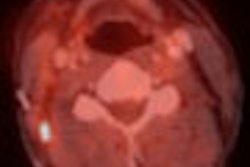ORLANDO, FL - Correctly staging and restaging lymphoma, both Hodgkin's and non-Hodgkin's, is crucial for patient management. Researchers from Stanford University Medical Center in Stanford, CA, evaluated patients with biopsy-proven lymphoma and found FDG-PET/CT to be superior to other modalities for staging, restaging, and anatomic localization.
"FDG-PET/CT is more accurate than FDG-PET, PET/CT, and dedicated CT with contrast in staging and restaging lymphoma," said Dr. Carina Mari, during a talk at the Academy of Molecular Imaging (AMI) meeting on Tuesday. Mari, the nuclear medicine chief resident in the department of radiology at the university, presented the results of research conducted by a team from the nuclear medicine division and molecular imaging program at Stanford.
The researchers evaluated 167 patients (102 males and 65 females with a mean age of 48) with biopsy-proven lymphoma (53 Hodgkin's, 114 non-Hodgkin's). They conducted a total of 338 FDG-PET/CT scans for 109 Hodgkin's and 229 non-Hodgkin's cases (54 staging and 284 restaging) on a Discovery LS PET/CT scanner (GE Healthcare, Chalfont St. Giles, U.K.), Mari said.
The patients fasted for six hours and were administered 15 (±5) mCi of 18F-FDG one hour before scanning. A transmission scan, a noncontrast CT scan, and a PET emission scan were then conducted, she said.
The FDG-PET scans were evaluated separately as PET/CT fusion, PET attenuated corrected with nondedicated noncontrast CT, PET alone that was attenuated corrected, and PET/CT -- noncontrast CT for PET attenuation correction read with the PET findings. In addition, 45 patients underwent dedicated CT with contrast within 15 days of their FDG-PET/CT scan.
The scans were staged or restaged according to the Ann Arbor classification, a surgical-treatment staging schema that identifies the involvement of disease by amount and site. The criteria for CT was a nodal size of greater than 1 cm, with inguinal lung nodules characterized at greater than 1.5 cm. For FDG-PET, the criteria was a standardized uptake value (SUV) of greater than 2.5, except for physiologic or variant, Mari noted.
According to Mari, the group's gold standard was the oncologist's final staging of the disease after histopathology, clinical follow-up after three months, an FDG-PET/CT follow-up, and other imaging methods, as well as labs and clinical exams.
The researchers reported FDG-PET/CT was correct in staging or restaging 92% of the patients, correct but inadequate in 1%, and incorrect in 7%. Standalone PET was correct in 90% of the cases, correct but inadequate in 2%, and incorrect in 8%. In contrast, the CT images resulted in correct staging or restaging in 42% of the patients, correct but inadequate in 11%, and incorrect in 46%.
Dedicated CT with contrast had the poorest showing, with only 27% of the patients correctly staged or restaged, 9% of the cases were correct but inadequate, and 64% cited as incorrectly staged, according to Mari.
Although FDG-PET/CT was just slightly better than PET alone in restaging (5%), it provided better (17%) anatomic localization than standalone PET, she noted.
A total of 117 patients had their disease management changed as a result of undergoing an FDG-PET/CT scan. For Hodgkin's disease, FDG-PET/CT upstaged 15 patients and downstaged 23 for an overall management change in this cohort of 35% (38/109). For non-Hodgkin's lymphoma, 44 patients were upstaged and 35 were downstaged for an overall management change of 34% (79/229).
The use of FDG-PET/CT resulted in a change of patient management in 99% of the 117-patient cohort, Mari said. PET alone would result in a management change in 97.5% of the patients, while PET/CT would have altered management in 45% of the cases and contrast-enhanced CT in only 2%, she said.
Mari noted that, in this study, FDG-PET/CT's principle strength was in restaging lymphoma. There was no patient management change in staging the Hodgkin's cases, although 38 restaging cases saw management change due to use of the technology. This seemed to correlate in the non-Hodgkin's cases as well, in which patient management was altered in only four staging cases, but it was changed in 75 restaging cases.
"FDG-PET/CT's improvement in accuracy implies subsequent changes in patient management," she said. "More often this is in downstaging the patient, which may imply economic advantages for its use."
By Jonathan S. Batchelor
AuntMinnie.com staff writer
March 23, 2005
Related Reading
PET registry previewed at AMI meeting, March 21, 2005
PET/CT planning allows for greater gamble on NSCLC radiotherapy, March 16, 2005
PET/CT demonstrates staging strength over PET, CT, and PET plus CT, March 7, 2005
PET/CT hardware hybrid tops PET, software fusion for NSCLC staging, December 7, 2004
Copyright © 2005 AuntMinnie.com




















